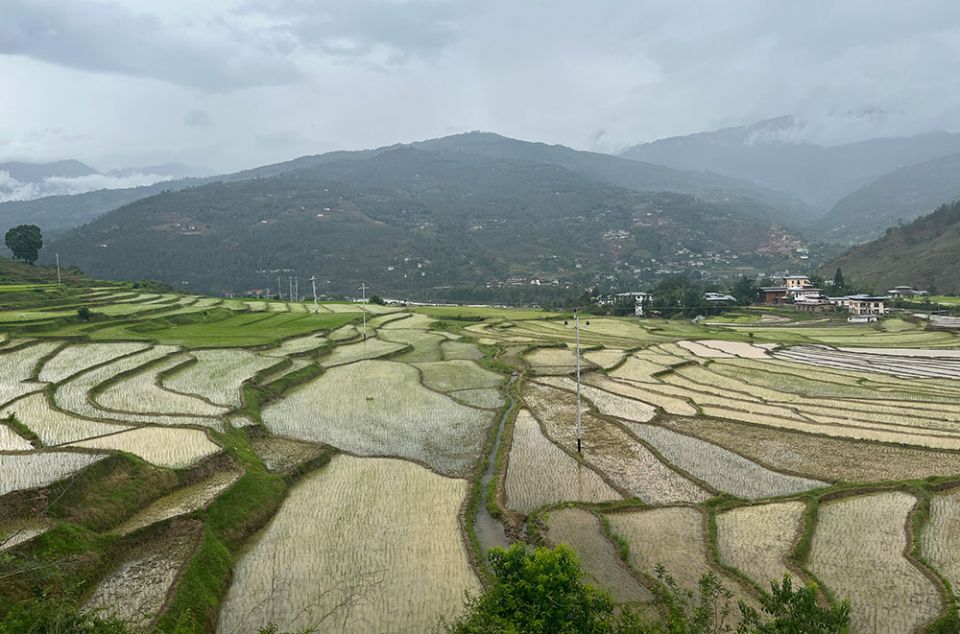
Foreign labour been explored as a solution
Punakha—The absence of hands to till the land has left land to follow in the otherwise fertile agricultural land in Punakha.
Records from the dzongkhag agriculture sector reveal that over 1,455 acres of land, encompassing both wet and dry areas, have been left fallow in 11 gewogs of the dzongkhag.
Punakha boasts a total land area of 8,373 acres of wetland and 2,347 acres of dry land. However, out of this expanse, about 7,457 acres of wetland and 1,732 acres of dry land remain uncultivated. Additionally, 143.2 acres are designated as orchards.
The dzongkhag had 597.4 acres of fallow land in 2019, according to the RNR Census report 2019 by NSB.
This phenomenon is not only in Punakha. Many farm lands in the country are being left fallow, with the size increasing each year.
Farmers blame the rural to urban migration for fallowing land. “Due to youth migration abroad or to urban areas for employment, only elderly are left in the villages who are unable to work in the fields,” said Sonam, a 55-year-old resident of Lakhu, Punakha. “Hiring labour is costly. With no alternative, we are forced to abandon farm work.”
Farmers said that hiring foreign workers could effectively revive fallow land nationwide and increase production.
The daily wage rate for agricultural labourers has seen a surge with some demanding Nu 1000, excluding meals and beverages in Punakha.
Labour shortages especially during the paddy plantation is considered the primary cause, leading many farmers to abandon agricultural works.
Meanwhile, the Department of Agriculture (DoA) is implementing various strategies to curb the issue with import of seasonal foreign labor seen as a potential solution to address the labour shortage.
The director of the Department of Agriculture, Yonten Jamtsho, said the department is concerned about the growing size of fallow land.
He said that while this has been caused mainly by labour shortage, inadequate irrigation and human wildlife conflict are other factors. “The department is providing support in irrigation, fencing and possible import of foreign labourers,” he said.
The department also identified suitable new agricultural land within the government reserve forests (GRF) to provide on lease for interested private individuals and firms for commercial agricultural farming. “This is expected to offset the concerns of increasing fallow land,” he said.
The department has developed a proposal on import of seasonal foreign labour and discussed with the labour and immigration department.
The proposal will be submitted to Cabinet for further deliberation.
If the proposal is approved, the department has plan to pilot the proposal in two dzongkhags, Samtse and Paro to evaluate its efficiency and potential scalability.
Water scarcity is identified as another factor contributing to the issue. The director said that the department has been implementing various initiatives to enhance water efficiency, particularly through the adoption of micro-irrigation techniques such as drip irrigation, for vegetable cultivation.
According to DoA, agricultural land constitutes 2.6 percent of the total land area of the country, equivalent to approximately 250,000 acres. Out of this, fallow land comprises 66,120 acres, accounting for 26 percent of the agricultural land.
In 2022, the Ministry of Agriculture and Livestock and the National Land Commission Secretariat conducted a pilot survey to evaluate the status and distribution of fallow land and to explore innovative agricultural uses for it.
The pilot study revealed that major reasons for leaving land fallow include labour shortages, inadequate water or irrigation infrastructure, human-wildlife conflicts, and the distance of land plots from human settlements.
Additional factors included inaccessible roads, remoteness from human settlements, challenging topography with steep slopes, and land degradation or the risk of landslides.












